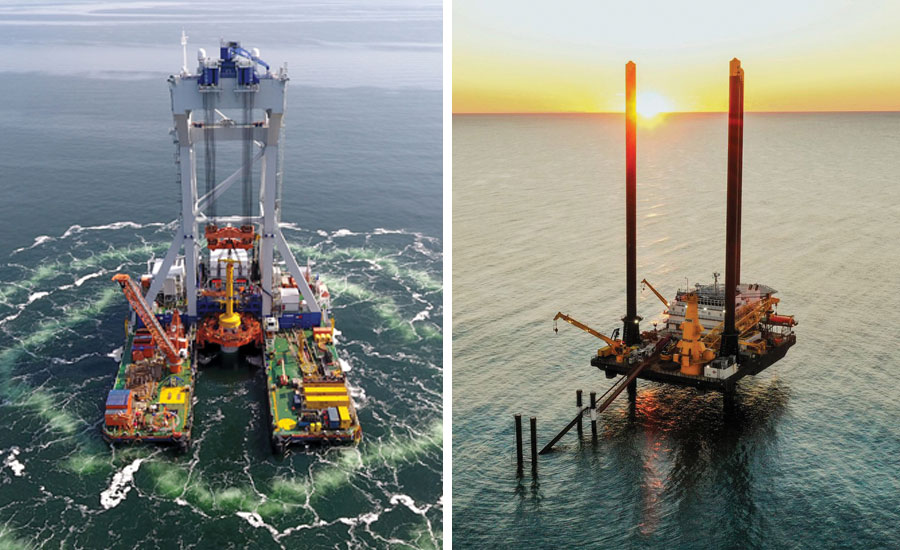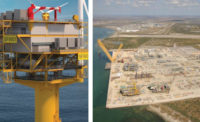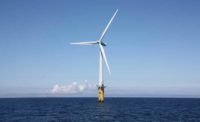This year is shaping up as key for construction of America's first two utility-scale offshore wind energy projects. The 800-MW, estimated $3-billion Vineyard Wind project off Massachusetts and the 132-MW, estimated $637-million South Fork project off New York could begin to generate power this year, their developers say.
Currently, there is 42 MW of offshore wind operating in the U.S., the 30-MW Block Island project off Rhode Island and the 12-MW CVOW pilot site off Virginia.
Avangrid Renewables, a unit of Spain’s Iberdrola, and Copenhagen Infrastructure Partners are building Vineyard Wind 15 miles off Martha’s Vineyard. It is set to have 62 GE Haliade-X turbines. each 13 MW and spaced 1 nautical mile apart. The project is the first of this scale to gain U.S. federal approvals, despite about 18 months of delay by the Trump administration. Massachusetts has a goal to purchase 5.6 GW of offshore wind by 2027 that it says could power 400,000 homes.
On May 24, the project's first European-made turbine components arrived at the New Bedford Marine Commerce Terminal, the project staging site, for installation starting in summer of structures to be more than 850 ft high. Project developers. Vineyard Wind CEO Klaus Moeller said at a May 15 briefing that crews would install 10 turbines per month, predicting some power production by year end and buildout finished by summer 2024. The project signed a lease with the state to be the terminal's first tenant.
The U.S. arm of Italy-based contractor Prysmian Group has installed four of six sections of two export cables that will link its power to the New England grid at a site in Barnstable on Cape Cod, a project spokesman says. A connecting substation is about three-quarters complete. “We’re also doing some preparation for [turbine] foundations, which should go in coming weeks with late summer installation,” he says. “Array cable installation will begin at the end of summer.”
With new cost issues now weighing on the future of two other state offshore wind projects, Commonwealth Wind and SouthCoast Wind, formerly Mayflower Wind, he earlier told media that “I hope the effect of actually having turbines out there makes everyone have a little bit more confidence.”

Vineyard Wind offshore wind project in Massachusetts is using underwater surveillance technology to avoid marine life impacts (left), while a 180-ft by 130-ft jack-up vessel supplied by oil and gas sector firms will aid directional drilling and conduit construction for South Fork Wind, being built off New York
Images: Hydrotechnik-Leubeck, left; Orsted, right
Opponent lawsuits have also dogged Vineyard Wind, including those claiming harm to fishing interests as well as to marine mammals and other life. But earlier this month federal courts dismissed one that claimed project construction and operation violates U.S. law in potential harm to the endangered North Atlantic right whale and another brought by a fisheries group, stating its claim of harm was brought too late.
In doing foundation installation starting next month, the project will use double-bubble curtain acoustic mitigation technology to protect marine life in a $5-million pilot with ThayerMahan, a Groton, Conn., maritime surveillance firm. Richard Hine, its COO, says the company is the U.S. partner of Germany-based Hydrotechnik-Leubeck, which developed the technology and has used it for nearly two decades in Europe and elsewhere. Vineyard Wind’s Industry Accelerator Fund, run by the industry-boosting Massachusetts Clean Energy Center, is funding the pilot.
In its first annual report to state officials, Vineyard Wind says it has more than doubled 2017 projections in jobs created and economic development impact since then, and it also met a key component of its July 2021 project labor agreement signed with regional building trades unions, in the number of union employees hired last year.
Developers also signed a new labor agreement on June 1 with the International Longshoremen’s Association related to port activities in New Bedford, following picketing by Local 1413 of the union that was not part of the original labor pact. "We’ve made an arrangement with the local stevedoring company to ensure that local workers will fill the jobs that are necessary to build this first in the nation project,’ said Vineyard Wind CEO Moeller in a statement.
Bristol Community College is set to open its National Offshore Wind Institute in New Bedford in late summer to train and certify workers.
First Mover
South Fork, a 50-50 joint venture of utility Eversource Energy and Denmark-based Ørsted, and approved by the U.S. Interior Dept. in 2021, is set to be the first wind project completed with utility scale turbines, a total of 16, about 30 miles off Montauk, N.Y. It finished onshore export cable system installation in East Hampton,N.Y., this month, developers said.
That joint venture now is set to change, as the firms confirmed on May 25 that Eversource will exit the offshore wind generation business, announcing sale to Orsted of its 175,000-acre ocean lease area in a $625 million deal set to close in the third quarter. Also being negotiated, reports say, is the expected sale of the Eversource 50% stake in ths South Fork project and in land-based port acreage in New York and Rhode island and other assets.
The firms have also been developing the 920M Sunrise Wind project in New York and the 704-MW Revolution Wind project set to supply power to Rhode Island and Connecticut. Eversource has indicated it wants to focus investment in expanded power transmission for these and similar projects.
Orsted said June 1 that it has completed purchase of the 25% stake held by New Jersey utility PSEG in the 1.1 GW Ocean Wind I flagship offshore wind project off that state's coast, to assume full ownership. The project is expected to win full federal environmental approval this year.
Related to the South Fork project, Haugland Group, Melville, N.Y., led installation of its duct bank system, a new onshore substation and interconnection of transmission lines, and LS Cable installed onshore cables. Challenges included work in the busy Long Island Rail Road right-of-way and in “a sensitive neighborhood,” and a ban on summer work in roadway areas, according to Haugland vice president Katherine Zimmerman. “This is a generational change in the transmission marketplace,” she said. “It is truly a rising tide where all boats can be lifted, and we are excited to be a first mover in the offshore wind space.”
A 40-acre terminal at the New London, Conn. port area has undergone a $250-million renovation, including $75 million from South Fork developers as the project marshalling and assembly ports. It will also serve their 920 MW Sunrise Wind and 704MW Revolution Wind projects.
Meanwhile, the Jill, a 180-ft by 130-ft jack-up vessel that was manufactured and supplied by Gulf Coast oil and gas sector firms is being deployed for directional drilling and conduit construction along the coastline. The South Fork project also will feature the first American-made offshore energy substation, now being completed by Kiewit Corp. at its 555-acre Texas offshore oil and gas infrastructure fabrication site.
The 1,500-ton, 60-ft-tall structure “will depart from … Texas in the coming days and transit up the East Coast to the offshore project site,” a South Fork spokeswoman told ENR on May 19. Offshore turbine foundation construction is expected to get underway in early summer.
“The project remains on track to be in operation by the end of this year,” she added.







Post a comment to this article
Report Abusive Comment